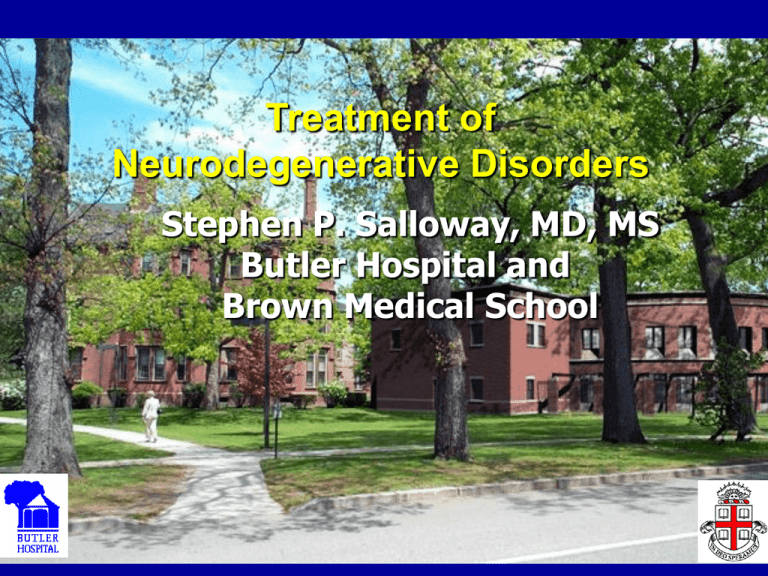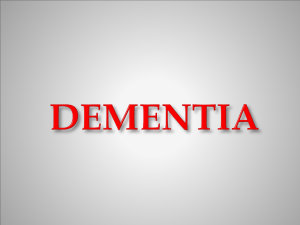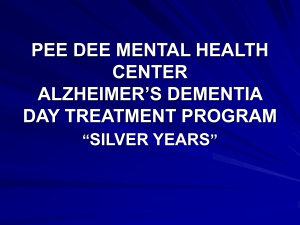Dr. Salloway's Powerpoints
advertisement

Treatment of Neurodegenerative Disorders Stephen P. Salloway, MD, MS Butler Hospital and Brown Medical School Disclosure Research Support, Consultation and Honorarium: Eisai, Pfizer, Johnson and Johnson, Forest, Lilly, Novartis, Aventis, Athena, Ono, Neurochem, Elan, Myriad and Sention, NIH, Alzheimer’s Association Off label discussion of CHEI for mild cognitive impairment and Memantine for mild-moderate AD • Median survival of women in the longest-lived countries has increased 3 months per year since 1840 Oeppen J et al. Science. 2002;296:1029-1031 Life Expectancy in Years Most of Us Will Be Living Out Our Full Lifespan and a Major Goal Is Healthy (Brain) Aging Year Projected Prevalence of AD 4 Million AD Cases Today— Over 14 Million Projected Within a Generation 16 14.3 14 11.3 12 10 8.7 8 6 4 5.8 6.8 4 2 0 2000 2010 2020 2030 Year 2040 2050 Evans DA et al. Milbank Quarterly. 1990;68:267-289. Alzheimer’s Disease Risks • Established – Age – Apolipoprotein E ε4 genotype • 4/4 increases risk 8 fold, any 4 increases risk 3 fold – Chromosome 1, 14, 21 mutations – Family history of dementia-RR 3.5 – Family history of Down syndrome-RR 2.7 – Head trauma with LOC-RR 1.8 – History of Depression-RR 1.8 • Others – Low educational level, female gender Geldmacher, 2001; Knopman, 2002 5 Cumulative Incidence of Alzheimer’s Disease 60 50 40 Alzheimer's 30 Disease (%) 20 10 0 65 70 75 80 85 Age (years) Age is the biggest risk factor for AD 90 Teaching Old Dogs New Tricks • 2 year study, old beagles (7-11 years; n=48) 4 groups divided into 1) antioxidant-fortified diet, 2) program of behavioral enrichment, 3) both, or 4) neither. • Discrimination and reversal learning ability decline progressively with advanced age in beagles, but the rate of decline was delayed by both behavioral enrichment and antioxidant supplementation. • Behavioral enrichment and antioxidant supplementation combined were more effective than either alone. Milgram et al., Neurobiology of Aging 26 (2005) 77–90. Keeping Our Synapses Healthy • Stay mentally and physically active-read, do crossword puzzles, play bridge and games, walk, exercise, go to the gym • Stay involved with people and projects- socialize, pursue hobbies and volunteer work, learn new things, play music, participate in church activities • Control risk factors-weight, BP, chol, blood sugar, stop smoking • Eat a balanced diet with Vit Eanimals on calorie restriction live longer, low calories may decrease risk of AD. ? Red wine-resveratrol Defining the Diagnostic Threshold for Dementia Cognitive Continuum Normal Mild cognitive impairment Dementia Mild-Mod AD, Mod-Severe AD Functional continuum Normal Aging • Psychomotor Slowing – Taking longer to do things – A 75 year old marathon runner takes twice the time to complete the race as he or she did at age 25. – Recalling names or trouble finding specific words – “What did I come here for?” • Troublesome signs – Being repetitive and not just for emphasis – Not coming up with the names or words later – Not recalling that conversations or events ever took place – Not realizing that there is a memory problem John A. Kelley in the Boston Marathon Age 27 Time: 2:37:07 (1st Place) 1935 Age 83 Time: 5:42:54 1991 Ed Whitlock, Age 73 Ed Whitlock’s Fastest Times Since Turning 70 EVENT TIME AGE 5,000 meters 18:22 73 10,000 meters 37:33 73 15,000 meters 58:55 72 Marathon 73 2:54:49 • First person over 70 to break the three-hour mark. • Ran Toronto Waterfront Marathon in 2:54:49, placing 26th out of 1,690 finishers. • Was a runner in high school and university, then stopped running for 20 years. • Began running again at age 41. Subtypes of Mild Cognitive Impairment MCI Amnestic MCI Multiple Domains Slightly Impaired MCI Single NonMemory Domain Alzheimer’s Disease Alzheimer’s Disease Vascular Dementia (VaD) ? Normal Aging Frontotemporal Dementia (FTD) Lewy Body Dementia (LBD) Primary Progressive Aphasia (PPA) Parkinson’s Disease (PD) Alzheimer’s Disease Not all patients with MCI have AD, but almost all patients with AD pass through an MCI stage What is Mild Cognitive Impairment? • Disorder of short-term memory (> 1.5 SD) • Misplacing things a lot • Hard to recall messages, remember details, and appointments • Normal functioning overall • More than a nuisance • Risk factor for AD (12-15% per year) Subtle Findings in MCI MMSE=26 MMSE=21 MCI AD 1/29/2004 MMSE=26 Volume of AD Cases by Specialty Specialists providing care Number of dementia patients in physician’s practice 180 Other Psych 7% 8% 120 121 99 Neuro 18% 60 63 48 PCP 67% 0 GP/FP IM Neuro Source: NDTI (Diagnosis codes: 3310, 2900, 2901, 2902, 2903, 2904, 3109, 2912), Moving Annual Total (MAT). March 2001. Source: Market Measures, February 2000. Psych Recommendations for Screening • At annual physical or when warning signs appear • Ask the patient and a knowledgeable informant about any problems with memory, mood, behavior or problems driving • Do a baseline MMSE and clock drawing • If time is short do the 3 word recall during the exam and clock drawing Neurodegenerative Disorders • Protein dysmetabolism • Vulnerable cell populations • Neural systems affected – Specific regions and neurotransmitters • Clinical phenotype – Systems linked to cognitive and behavioral changes • Disability • Age dependent onset • Genetic and environmental risk factors – ApoE and head injury The Temporal Course of Neuropathological Changes of AD in Down’s Syndrome Age 10 20 30 40 50 Amyloid Deposition Microglial Changes Neurofibrillary Tangles Neuronal Loss/ Neurochemical Changes 60 70 Mann DMA. BMJ. 1997(Oct 25);315:1078-1081 Dementia Figure 4. Appearance of plaques and DAT 70.00 Amyloid Plaques (Braak & Braak) Proportion (%) 60.00 50.00 DAT - Average of Three Studies 40.00 30.00 20.00 10.00 0.00 46-50 51-55 56-60 61-65 66-70 71-75 Age (years) Courtesy of Dr. Mark Mintun 76-80 81-85 86-90 Braak Staging of AD Trans-entorhinal (I-II) Limbic (III-IV) Isocortical (V-VI) Change in Hippocampal Volume from Normal Aging through AD Normal % of nl >50% of nl 1-50% 1st % Jack Neurology 1999;52:1397-1403 MCI AD conversion rate 9% 26% 50% PET for the Diagnosis of Dementia Medicare Guidelines •Atypical course for AD and FTD is suspected • Comprehensive eval conducted by a physician experienced in dementia • PET reading done by a physician experienced in dementia imaging • No prior SPECT or PET • Clinical trials using PET for dx of early dementia may be covered Amyloid Imaging Pittsburgh compound Assessment Clinical history Primary symptoms from patient and informant Onset and course Gradual, abrupt Were there “events”? Determining baseline cognitive and functional ability Assessment Domains Cognitive Memory, language Fluctuations? Activities of daily living (ADLs) IADLs, BADLs, driving, hobbies Behavioral Mood, irritability, impatience, apathy Delusions, visual hallucinations, paranoia Substance use Sleep, appetite IADLs = instrumental ADLs; BADLs = basic ADLs Assessment Motor and Gait weakness, numbness, lateralizing? Parkinsonism Bladder control Other medical conditions and medications Family history: dementia, psychiatric, neurological 12 Predicted Result of Early Treatment Cognitive Function Early Treatment No Treatment Time Modern medicine relies on the premise of early diagnosis and treatment to prevent or delay morbidity. Moderate AD Age 77 Sep 1998 Age 79 Aug 2000 Age 82 Oct 2002 Age 84 2004 MMSE: 19 MMSE: 15 MMSE: 12 MMSE 10 300 250 200 DLBD* AD PD* NC LBV** 150 100 p-value = 0.0001 (Kruskal-Wallis ANOVA) 50 0 MF ChAT There is a Pronounced Cholinergic Deficit Early in LBD *p<0.05 compared to AD; p<0.001 Compared to NC (Dunn’s multiple comparisons test); **p<0.001 compared to AD and NC (Dunn’s multiple comparisons test); Tiraboschi P, Hansen LA, Alford M. Neurology. 2000;54:407-411 Cholinesterase Inhibitors for AD Tacrine (Cognex) Donepezil (Aricept) Physostigmine SR (Synapton) Rivastigmine (Exelon) Metrifonate Galantamine 32 Outcomes Measured in Reminyl® (galantamine HBr) Phase III Trials Cognition Outcomes in Reminyl® trials Caregiver burden Global change Behavioral disturbances Activities of daily living Benefits of CHEI for AD • Stabilize functioning during the first year and make subsequent decline more gradual • Delay time to nursing home placement • May decrease behavioral symptoms • Show some benefit in moderate severe stages of AD • The CHEI’s have similar efficacy but may have differences in tolerability and ease of use Mean change from baseline ( SE) Donepezil Pivotal Trials ADAS-cog scores in mild to moderate AD 2.5 1.5 Clinical improvement 0.5 Baseline -0.5 Clinical decline -1.5 -2.5 -3.5 Baseline Donepezil 5 mg/d Donepezil 10 mg/d Placebo 6 12 18 Study week Rogers SL, et al. Neurology.1998;50:136-145. 24 30 38 Long-term Effects of Donepezil on Cognition: ADAS-Cog Mean Change From Baseline Improve -6 0 6 12 Decline in ADAS-Cog score based on the natural history of untreated patients with moderate Alzheimer’s disease Decline 18 0 6 12 14 26 38 50 62 74 86 98 Probability of Remaining at Home Delay Time to Nursing Home Placement 1 0.8 Placebo High Dose Higher Dose 0.6 0.4 0 100 200 300 400 500 Days 600 700 800 Most Common Side-Effects With Cholinesterase Inhibitors • Gastrointestinal – Nausea, Vomiting, Loose stools, Diarrhea • Anorexia and weight loss • Vivid Dreaming Symptoms are usually transient and dose relatedtitrate slowly and take with food A small percentage become agitated on CHEI’s MCI - Amnestic 70 60 50 40 30 20 10 Speed Attention Delayed Recall Recognition Spatial/Constr Lang/Naming Executive Cognitive Change in the 24 week Donepezil MCI Trial 3.5 P=.007 P=.044 LS Mean Change From Baseline 3.0 Donepezil 2.5 Placebo 2.0 1.5 1.0 0.5 0.0 (n=130)(n=132) ITT-LOCF *FE=fully evaluable Salloway et al. Neurology. 2004;63:651-657. (n=83) (n=100) FE* Results of the 36 month ADCS MCI Conversion Trial • Conversion rate to dementia was 13% per year, 98% determined to be to AD • APOE-ε4 + 55.1%. Rate of conversion was significantly higher in the APOE4 positive group • There was no significant effect of donepezil or vitamin E on conversion over the full 3 year study • Donepezil appeared to decrease the probability of conversion for up to 18 months and delay the conversion to dementia by 6 months overall • The delay to conversion was greatest in the APOE4 positive group Lancet 2004;363: 2105-2115 Driving and Dementia X X X Normal Driving No driving No driving Local driving Not Driving at night on highways only Driving Evaluation Gets lost No strange places No driving due to crash Bad Option! Driving Spectrum of Neuropsychiatric Symptoms in AD Behavior Apathy Delusions Hallucinations Agitation Dysphoria Disinhibition Mega et al, 1996 Mild 47% 12% 12% 47% 12% 35% Moderate Severe 80% 92% 25% 31% 15% 8% 55% 85% 45% 62% 40% 54% Helping Caregivers Cope • • • • • • • • Face the situation directly Common sense problem solving Get educated and develop a support network Structuring the home environment Familiar, calm environment with a predictable routine Keep it simple, limit choices Match activities to capacities and preferences Avoid arguing and overwhelming situations and challenges • Driving and home safety Use of Glutamatergic Agents for Rx of Memory Loss • Glutamate plays an important role in memory consolidation and LTP • Therapeutic approaches-NMDA agonists and antagonists, AMPA receptor modulators, glycine modulators • Memantine is a low to moderate affinity, uncompetitive NMDA-receptor antagonist, voltage-dependent, fast blocking/unblocking kinetics – Blocks the effects of abnormal glutamate activity that may lead to neuronal cell damage/loss and cognitive dysfunction – Preserves physiological activation of NMDA receptor required for learning and memory Sources: Rogawski MA, et al. CNS Drug Reviews. 2003;9:275-308. Danysz W, et al. Neurotoxicity Res. 2000;2:85-97. Memantine: Mod-Severe Monotherapy AD Trial • 28 week trial of memantine 20mg/d vs placebo in mod-severe AD, MMSE 7.9 • N=252 • Outcomes – Primary-CIBIC+ and ADL – Secondary-SIB, MMSE, NPI • Sig slower decline in the memantine group in CIBIC, ADL and SIB • No sig difference in MMSE and NPI • Caregiver time was sig less in the drug group NEJM 2003;348:1333-41 Memantine: Mod-Severe Monotherapy AD Trial Memantine Plus Aricept for Mod-Severe AD • 28 week study, n=403, mean MMSE 10, range 5-14 • Aricept 10 plus memantine 20/d vs Aricept 10 and placebo – Had to be on Aricept 10 mg for at least 6 months, mean duration of Aricept Rx-24 mos. • Outcomes – Primary- ADL and CIBIC+ – Secondary-SIB, NPI • Patients on combined Rx declined at a sig slower rate and showed improvement on the SIB • Aricept-memantine combination well tolerated • ? Decreased benefit in the <10 group JAMA 2004;291:317 Memantine Plus Aricept for Mod-Severe AD What about the new preventative and disease modifying treatments? • • • • • • Vitamins Anti-inflammatory agents Estrogen Statins Mood stabilizers Treatments to reduce amyloid load – Amyloid vaccine – Secretase inhibitors – Heavy metal chelators • Shunting AD patients New Targets for Treatment of Alzheimer’s Disease Three approaches to Altering Brain Amyloid in Alzheimer’s Disease 1. Reduce β-amyloid production 2. Inhibit β-amyloid fibrillogenesis 3. Promote β-amyloid clearance New Targets for Treatment of Alzheimer’s Disease Amyloid Fibril Nerve Cell Proteolytic Cleavages of Amyloid Precursor Protein (APP) That Produce A Peptide -amyloid precursor protein NH Extracellular space TM A peptide COO H 2 secretase Abeta-42 Selkoe DJ et al. JAMA. 2000;283:1615-1617. Cytoplasm alpha-secretase Abeta-40 secretase Abeta-42 Parietal neocortex, immunized AD patient in Elan AN-1792 Trial Parietal neocortex, Nonimmunized patient at comparable stage of AD The Meningoencephalitis Induced by Active Amyloid Immunization With AN-1792 Was T-Cell Mediated CD3 T-cell antibody stain shows extensive meningeal reactivity in response to AN-1792 Hock et al. Neuron. 2003;38:547-554. CD79a B-cell antibody stain shows no meningeal reactivity in AN-1792 induced meningoencephalitis Tau Hyperphosphorylation Stabilizing Tau Molecules Healthy Neuron Microtubule s Disintegrating Microtubule Diseased Neuron Disintegratin g Microtubules Art from ADEAR Microtubule Subunits Fall Apart Tangled Clumps of Tau Proteins Improving the Treatment of Dementia • Develop routine screening for memory loss and behavior change in older people • Diagnose and treat signs of dementia early and maintain persistent treatment • Educate caregivers about the illness, help them structure the daily routine and assist them with obtaining support over the long-term • Work with determination to develop effective new treatments that dispel the angst associated with AD • Build a partnership of civic leaders, scientists, clinicians, and families to wage a concerted fight against AD 3/15/2004 MMSE=22 Leaves out numbers on left side 3/15/2004 MMSE=22







